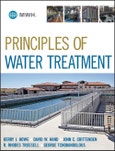Table of Contents
Preface xv
Acknowledgments xvii
1 Introduction 1
1-1 The Importance of Principles 2
1-2 The Importance of Sustainability 4
References 4
2 Water Quality and Public Health 5
2-1 Relationship between Water Quality and Public Health 5
2-2 Source Waters for Municipal Drinking Water Systems 9
2-3 Regulations of Water Treatment in the United States 17
2-4 Evolving Trends and Challenges in Drinking Water Treatment 21
2-5 Summary and Study Guide 23
References 24
3 Process Selection 25
3-1 Process Selection Based on Contaminant Properties 26
3-2 Other Considerations in Process Selection 30
3-3 Sustainability and Energy Considerations 34
3-4 Design and Selection of Process Trains 39
3-5 Summary and Study Guide 42
Homework Problems 43
References 45
4 Fundamental Principles of Environmental Engineering 47
4-1 Units of Expression for Chemical Concentrations 48
4-2 Chemical Equilibrium 51
4-3 Chemical Kinetics 60
4-4 Reactions Used in Water Treatment 63
4-5 Mass Balance Analysis 66
4-6 Introduction to Reactors and Reactor Analysis 73
4-7 Reactions in Batch Reactors 77
4-8 Hydraulic Characteristics of Ideal Flow Reactors 80
4-9 Reactions in Ideal Flow Reactors 84
4-10 Measuring the Hydraulic Characteristics of Flow Reactors with Tracer Tests 88
4-11 Describing the Hydraulic Performance of Real Flow Reactors 95
4-12 Reactions in Real Flow Reactors 101
4-13 Introduction to Mass Transfer 103
4-14 Molecular Diffusion 104
4-15 Diffusion Coefficients 106
4-16 Models and Correlations for Mass Transfer at an Interface 115
4-17 Evaluating the Concentration Gradient with Operating Diagrams 126
4-18 Summary and Study Guide 131
Homework Problems 133
References 138
5 Coagulation and Flocculation 139
5-1 Role of Coagulation and Flocculation in Water Treatment 140
5-2 Stability of Particles in Water 142
5-3 Principles of Coagulation 149
5-4 Coagulation Practice 150
5-5 Principles of Mixing for Coagulation and Flocculation 162
5-6 Rapid-Mix Practice 163
5-7 Principles of Flocculation 165
5-8 Flocculation Practice 170
5-9 Energy and Sustainability Considerations 186
5-10 Summary and Study Guide 187
Homework Problems 188
References 190
6 Sedimentation 193
6-1 Principles of Discrete (Type I) Particle Settling 196
6-2 Discrete Settling in Ideal Rectangulor Sedimentation Basins 201
6-3 Principles of Flocculant (Type II) Particle Settling 205
6-4 Principles of Hindered (Type III) Settling 206
6-5 Conventional Sedimentation Basin Design 211
6-6 Alternative Sedimentation Processes 220
6-7 Physical Factors Affecting Sedimentation 228
6-8 Energy and Sustainability Considerations 230
6-9 Summary and Study Guide 231
Homework Problems 232
References 234
7 Rapid Granular Filtration 235
7-1 Physical Description of a Rapid Granular Filter 236
7-2 Process Description of Rapid Filtration 242
7-3 Particle Capture in Granular Filtration 246
7-4 Head Loss through a Clean Filter Bed 255
7-5 Modeling of Performance and Optimization 258
7-6 Backwash Hydraulics 266
7-7 Energy and Sustainability Considerations 273
7-8 Summary and Study Guide 274
Homework Problems 275
References 278
8 Membrane Filtration 281
8-1 Classification of Membrane Processes 282
8-2 Comparison to Rapid Granular Filtration 284
8-3 Principal Features of Membrane Filtration Equipment 286
8-4 Process Description of Membrane Filtration 296
8-5 Particle Capture in Membrane Filtration 301
8-6 Hydraulics of Flow through Membrane Filters 305
8-7 Membrane Fouling 309
8-8 Sizing of Membrane Skids 316
8-9 Energy and Sustainability Considerations 319
8-10 Summary and Study Guide 321
Homework Problems 322
References 325
9 Reverse Osmosis 327
9-1 Principal Features of a Reverse Osmosis Facility 329
9-2 Osmotic Pressure and Reverse Osmosis 335
9-3 Mass Transfer of Water and Solutes through RO Membranes 339
9-4 Performance Dependence on Temperature and Pressure 343
9-5 Concentration Polarization 348
9-6 Fouling and Scaling 353
9-7 Element Selection and Membrane Array Design 359
9-8 Energy and Sustainability Considerations 361
9-9 Summary and Study Guide 364
Homework Problems 365
References 368
10 Adsorption and Ion Exchange 369
10-1 Introduction to the Adsorption Process 370
10-2 Adsorption Equilibrium 377
10-3 Adsorption Kinetics 382
10-4 Introduction to the Ion Exchange Process 386
10-5 Ion Exchange Equilibrium 395
10-6 Ion Exchange Kinetics 399
10-7 Fixed-Bed Contactors 400
10-8 Suspended-Media Reactors 423
10-9 Energy and Sustainability Considerations 429
10-10 Summary and Study Guide 430
Homework Problems 431
References 435
11 Air Stripping and Aeration 437
11-1 Types of Air Stripping and Aeration Contactors 438
11-2 Gas–Liquid Equilibrium 443
11-3 Fundamentals of Packed Tower Air Stripping 449
11-4 Design and Analysis of Packed-Tower Air Stripping 459
11-5 Energy and Sustainability Considerations 471
11-6 Summary and Study Guide 472
Homework Problems 473
References 475
12 Advanced Oxidation 477
12-1 Introduction to Advanced Oxidation 479
12-2 Ozonation as an Advanced Oxidation Process 486
12-3 Hydrogen Peroxide/Ozone Process 494
12-4 Hydrogen Peroxide/UV Light Process 505
12-5 Energy and Sustainability Considerations 518
12-6 Summary and Study Guide 519
Homework Problems 520
References 522
13 Disinfection 525
13-1 Disinfection Agents and Systems 526
13-2 Disinfection with Free and Combined Chlorine 532
13-3 Disinfection with Chlorine Dioxide 538
13-4 Disinfection with Ozone 538
13-5 Disinfection with Ultraviolet Light 543
13-6 Disinfection Kinetics 555
13-7 Disinfection Kinetics in Real Flow Reactors 565
13-8 Design of Disinfection Contactors with Low Dispersion 567
13-9 Disinfection By-products 572
13-10 Residual Maintenance 575
13-11 Energy and Sustainability Considerations 576
13-12 Summary and Study Guide 578
Homework Problems 579
References 581
14 Residuals Management 585
14-1 Defining the Problem 586
14-2 Physical, Chemical, and Biological Properties of Residuals 591
14-3 Alum and Iron Coagulation Sludge 595
14-4 Liquid Wastes from Granular Media Filters 599
14-5 Management of Residual Liquid Streams 601
14-6 Management of Residual Sludge 604
14-7 Ultimate Reuse and Disposal of Semisolid Residuals 614
14-8 Summary and Study Guide 616
Homework Problems 617
References 618
Appendix A Conversion Factors 621
Appendix B Physical Properties of Selected Gases and Composition of Air 627
B-1 Density of Air at Other Temperatures 629
B-2 Change in Atmospheric Pressure with Elevation 629
Appendix C Physical Properties of Water 631
Appendix D Periodic Table 633
Appendix E Electronic Resources Available on the John Wiley & Sons Website for This Textbook 635
Index 637








